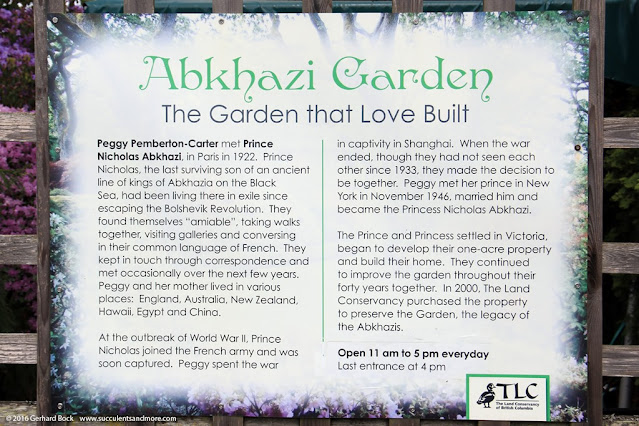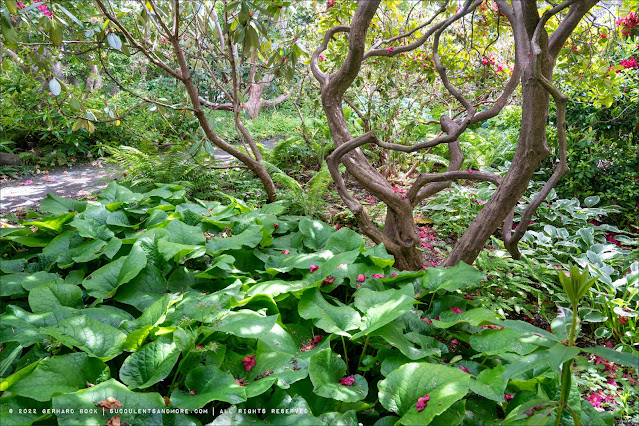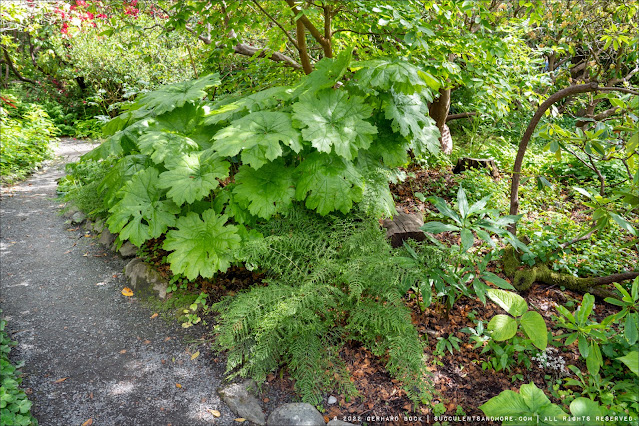When people think of gardens in Victoria, British Columbia, they immediately think of Butchart Gardens (see my recent post). My favorite, though, is very much the opposite: small, intimate, and quiet. No surprise, seeing how it started as a private garden, reflecting only the preferences of its original owners instead of a corporate business plan.
I’m talking about Abkhazi Garden, located in the Greater Victoria neighborhood of Fairfield. You could walk through the garden and thoroughly enjoy it without knowing a thing about its history—and I suppose people do. However, once you know who created the garden and how it came about, you’ll be able to appreciate it on a entirely new level.
I shared the history of Abkhazi Garden in this 2016 post, and it bears repeating here.
Some may not be willing to admit it, but all but the grinchiest among us enjoy a good love story. And a good love story gets even better when it plays out against the backdrop of war.
Our story starts in 1922 in Paris when 20-year old Peggy Pemberton-Carter, born in Shanghai, orphaned at age three, and raised by a world-traveling domineering adoptive mother, meets 23-year old exiled and penniless
Abkhazian prince Nicholas Abkhazi. Sparks fly, but Peggy’s mother, threatened by the budding romance between her daughter and the pauper prince, whisks Peggy back to Shanghai. Peggy and Nicholas stay in touch through letters but are kept apart by geography and circumstances.

Then comes the chaos and upheaval of World War II. Nicholas is interned in a prisoner-of-war camp in Germany, and Peggy in one near Shanghai. She keeps a diary during these tumultuous years and later writes a book entitled
A Curious Cage, published in 1981 when she was 79. (A biography,
A Curious Life, by Katherine Gordon came out in 2002.) After her release from camp in 1945, she uses a small stash of traveler’s checks she’d kept hidden in a talcum powder can to secure passage to San Francisco. From there she travels to Victoria where she has friends and purchases the 1-acre rocky lot that will become Abkhazi Garden.
In January 1946 Peggy receives a surprise letter from Nicholas. They had lost touch during the war, and neither one knew if the other had even survived. At Nicholas’ suggestion, they meet in New York—the first time they lay eyes on each other in 13 years. Now they are finally able to be together. She is 44, and he is 47. They return to Victoria where they marry in November 1946 and live a quiet, happy life. Nicholas dies in 1987 at the age of 88 and Peggy in 1994 at the end of 92.
This is where the story ends. Except it doesn’t. Peggy and Nicholas didn’t have children, but they spent four decades creating and refining a spectacular garden whose beauty draws visitors even now, long after their death. It became known as “The Garden that Love Built.”
In 2000, when developers wanted to destroy the garden and build a townhouse complex,
The Land Conservancy of British Columbia purchased the property and has managed it ever since. However, the threat of development never went away entirely. To remove any future possibility of development and ensure long-term protection for the garden, The Land Conservancy in partnership with a responsible local developer
applied for a “density transfer” in March 2022. This would transfer the Abkhazi Garden’s townhouse zoning to a site nearby, allowing multi-family housing to be built on that site while rezoning the Abkhazi Garden to mixed use and allowing it to receive an official heritage designation.
Most visitors (myself included) never think of these issues, but I’m very glad that a real effort is being made to protect one of the most unique sites in Victoria.
As you enter the garden from Fairfield Road, you walk through the Rhododendron Woodland Garden, home to variety of rhododendron species and hybrids growing happily under a canopy of Garry oaks.
Perennials with massive leaves, most of which I can’t even begin to identify, thrive in the shade.
 |
| I believe the purple-leafed plant is Rodgersia pinnata ‘Purple Peacock’ or a similar cultivar |
Steps lead from the Woodland Garden...
...to the Teahouse on top of the hill in the middle of the garden. We’ll get there in a little bit. For now...
...we’ll walk around the outer perimeter.
 |
| Wonderful textural contrasts |
 |
| Alliums are common ornamental plants in many parts of the world, yet challenging to grow where I live |
 |
| Allium sp. and purple cow parsley (Anthriscus sylvestris ‘Ravenswing’) |
Below is the Teahouse as seen from the North Lawn:
What is now the
Teahouse used to be Peggy and Nicholas Abkhazi’s home. It’s a fairly modest house on top of the large rock outcropping. Apparently, on a clear day you can see the
Strait of Juan de Fuca that separates Vancouver Island (and hence Canada) from the U.S. and the Olympic Mountains in Washington State beyond. Unfortunately, it was too hazy to see that far the day we visited.
 |
| The central and northern parts of the garden feature massive rock outcroppings |
 |
| The water lilies were just starting to flower |
The outcroppings may appear solid, but there are plenty of cracks where small amounts of soil accumulate—enough for plants to gain a foothold. I love the sight of plants seeming to grow right out of the rock.
 |
| Erigeron glaucus |
 |
| Purple houseleek (Sempervivum sp.) |
 |
| Narrow navelwort (Umbilicus horizontalis) |
 |
Even a small conifer!
|
More plants are growing in cracks in the steps on the Teahouse terrace. I assume they’re all volunteers, maybe from seeds brought in by the wind?
 |
| Erigeron karvinskianus |
 |
| Bellflower (Campanula sp.) |
 |
| Bellflower (Campanula sp.) |
 |
| Bellflower (Campanula sp.) |
Rounding out the rock garden theme, a number of stone troughs on the terrace and nearby are planted with sedums and sempervivums. This one, filled with solid cushions of
Sempervivum arachnoideum, was my favorite:
 |
| Woolly houseleek (Sempervivum arachnoideum ssp. tomentosum) |
And look what else I spotted:
 |
| Common wall lizards (Podarcis muralis) |
I didn’t know what they were—they’re far bigger than the fence lizards we have at home. A bit of Googling uncovered
this CBC News article from May 2021: They’re common wall lizards
(Podarcis muralis), native to Europe. More precisely, they’re the offspring of a few wall lizards that were carelessly released in the late 1960s. Now their population is an estimated 700,000 and they are causing damage to the local ecosystem
—apparently they eat bees and baby garter snakes (!).
 |
| Common wall lizard (Podarcis muralis) |
Unlike Butchart Gardens, which is located a good half hour northwest of Victoria, Abkhazi Garden is right in the city and easy to reach. If you ever get the chance to visit, do it. It’s the kind of garden only decades of personal dedication can build—or, in this case, love.
Abkhazi Garden is at 1964 Fairfield Rd. It’s open every day from 11 a.m. to 5 p.m. The Teahouse is open daily from 11 a.m. to 4:30 p.m.; for menus and more information,
visit their website.
RELATED POSTS:
© Gerhard Bock, 2022. All rights reserved. To receive all new posts by email, please subscribe here.









































I read both posts and I'm excited to plan a trip to see this garden with my own eyes.
ReplyDeleteSome folks spend a lot of money to bring in massive rocks to their gardens, others have the good fortune of rocks already "built-in". All the nooks and crannies that provide planting opportunities. I love it!
Chavli
So true! I've always gardened on flat ground with zero elevation change and no rocks. I'd love to have a house on top of a huge rock outcropping!
DeleteI love everything about this garden, from the creeping conifer to the plants seemingly growing out of rocks (with the possible exception of the invasive wall lizards, although they're handsome as lizards go). I'd very much like to visit the garden in person someday but I appreciate you sharing your photos in the meantime.
ReplyDeleteWe should have a mini gathering in Victoria! There's so much to see.
DeleteCongratulations to your daughter on her graduation. Does this mean no more trips up to Canada now? The Abkhazi Garden is a true gem and has over the years been threatened by development. A huge thank-you has to go out to those who have fought to keep it intact. It is easier to relate to as it was a private garden so it's character is much different than a garden meant purely for show. It's one of my favourites too.
ReplyDeleteMy daughter actually graduated two years ago but this was the first official convocation ceremony since Covid. She's still in Victoria and wants to stay so (keeping fingers crossed!) there'll be plenty more trips for me to BC.
DeleteI'm glad you like the Abkhazi Garden, too! It really is a treasure.